Jobs To Be Done Examples, Theory, Framework, Templates & Statements
Published: 10 December, 2023
Experience Design
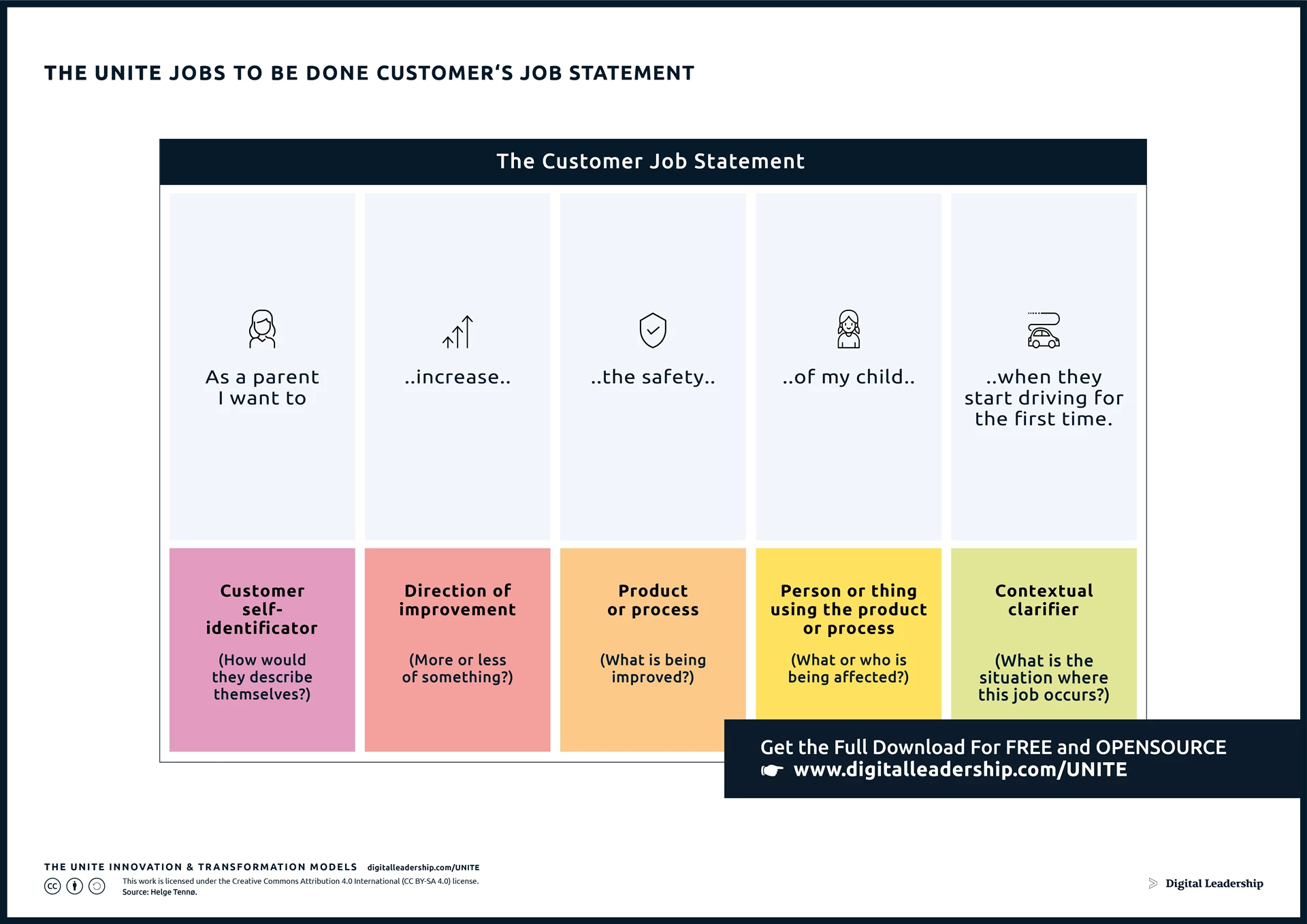
Table of Contents
Remaining responsive to customer needs has become a pivotal element in driving innovation and supporting initiatives for digital transformation. In this landscape, the Jobs to be Done (JTBD) theory, coupled with an effective digital transformation strategy and innovation strategy, becomes a central and invaluable method for identifying the unresolved challenges that customers encounter. Digital Leadership recognizes the critical role of JTBD in aligning customer needs with strategic digital initiatives, ensuring a seamless integration of innovative solutions within the broader framework of the digital transformation strategy to empower organizations to stay ahead in the business environment.
The job to be done (JTBD) theory doesn’t hinge on luck or assumptions derived from customer demographics. Instead, it aims to understand the fundamental tasks or “Customer Jobs” that customers aim to accomplish. Embracing this methodology enables enterprises to take a proactive approach to meeting customer needs and crafting value propositions and digital business models that authentically align with their aspirations.
Jobs to be Done (JTBD) provides organizations with a profound understanding of customer needs and motivations for innovation and digital transformation strategy, Digital Leadership integrates Jobs to be Done principles seamlessly into its Innovation Consulting and Digital Transformation Consulting services. By decoding fundamental customer jobs, our approach ensures strategic innovation aligned with market needs. As an initial step to assist businesses in selecting tailored services that align with their specific needs and objectives for innovation, we offer an Innovation Blueprint to evaluate current innovation practices.
In the following video, Stefan F. Dieffenbacher, the esteemed founder of Digital Leadership, offers a brief overview of the Jobs to be Done theory. Drawing on his profound expertise, he highlights how this theory drives outcome-oriented innovation and aligns seamlessly with overarching business strategy and goals.
What is the Jobs to Be Done Theory and Methodology?
Jobs to be Done Theory is a business theory and framework that offers a unique perspective on why customers make product purchases. Often referred to as jobs theory, it suggests that customers don’t simply purchase products; instead, they “hire” products to fulfil specific tasks, whether it’s solving a problem or satisfying a desire. JTBD meaning can encompass tasks, goals, objectives, problem-solving, avoidance, or any other accomplishment people seek in a given context.
The JTBD Theory posits that customers actively “hire” products or services with the intention of fulfilling specific jobs or tasks in their lives. This perspective transcends the conventional emphasis on product features or customer demographics. Instead, JTBD dives deep into the functional and emotional dimensions of the jobs customers aim to accomplish, fundamentally shifting the focus from the product itself to the intrinsic motivation propelling a customer’s purchase.
Key Components of the Jobs to be Done Theory:
- Jobs as Tasks or Goals:
- Customers actively “hire” a product or service to accomplish a particular job.
- Jobs are essentially tasks, goals, or problems that customers seek to solve.
- Focus on Customer Needs:
- The theory underscores a profound understanding of the fundamental needs and motivations of customers.
- This approach surpasses traditional market segmentation and demographic analyses.
- Functional and Emotional Dimensions:
- Acknowledges that jobs have both functional and emotional facets.
- Customers not only seek solutions that efficiently perform a task but also address their emotional needs.
- Customers as Decision-Makers:
- Views customers as decision-makers who actively select products based on their ability to fulfil specific jobs.
- Challenges the notion that customers are passive recipients of products.
- Continuous Improvement:
- Encourages a mindset of continuous improvement grounded in an ongoing comprehension of customer needs.
- Favors iterative innovation that aligns with the evolving landscape of customer jobs.
- JTBD Framework and Methodology:
- Involves a systematic approach to unearth customer jobs, map out their journeys, and align innovation with identified opportunities.
- Utilizes tools such as job statements, job maps, and customer criteria to glean valuable insights.
In practical terms, understanding the Jobs to be Done Theory involves recognizing that customers actively “hire” a product to fulfill specific needs or solve particular problems. This perspective has profound implications for product development, marketing, and overall business strategy. By aligning offerings with the jobs customers are trying to get done, organizations can create more meaningful and customer-centric solutions. The Jobs to be Done Theory, with its emphasis on job statements, job maps, and templates, emerges as a potent tool for businesses aiming to stay responsive to customer needs and drive innovation.
Much more about Jobs to be done and other approaches to innovation strategy you will find in our brand-new FREE book “How to Create Innovation” Register for the download now!
The Jobs to Be Done (JTBD) theory and methodology form a job to be done JTBD framework extensively utilized in product development, innovation, and marketing, gaining prominence through the efforts of Harvard Business School professor Clayton Christensen and his associates. The fundamental premise of JTBD is centred around the notion that individuals “hire” products or services to fulfill specific tasks in their lives, and a comprehensive understanding of these jobs is indispensable for creating successful products and meeting customer needs.
Key Concepts Associated with the Jobs to Be Done Theory:
- Jobs: In the JTBD context, a “job” denotes a task, problem, or goal that an individual seeks to accomplish. It encompasses not only the functional aspects but also the emotional and social dimensions associated with the task.
- Job Executor: The entity, whether an individual or a group, endeavoring to accomplish a job is termed the “job executor.” This could be a customer, user, or a team within a company.
- Job Map: The creation of a job map involves dissecting a job into its various steps, spanning from the initial trigger that prompts the job to the ultimate goal or outcome.
- Job Statement: A succinct articulation of the job a person is trying to get done, typically following the format: “When [situation], I want to [motivation], so I can [expected outcome].”
- Switching Costs: Within the JTBD framework, a pivotal concept is the idea that customers “hire” products to fulfil a job, and they may “fire” a product if it no longer serves that purpose. Switching costs, encompassing both real and perceived factors, influence whether a customer will transition from one product or service to another.
The application of the Jobs to Be Done methodology entails conducting research to unveil the jobs customers are endeavoring to accomplish, comprehending the context and motivations underlying those jobs, and utilizing that knowledge to design products or services that more effectively fulfill those needs.
This methodology is considered a complement to traditional demographic and psychographic approaches to understanding customer behavior. By concentrating on the functional, emotional, and social facets of the jobs customers are attempting to fulfill, businesses can attain profound insights into customer motivations and craft products that closely align with those motivations.
By strategically harnessing the Jobs to Be Done Methodology in tandem with impactful tools, organizations acquire a robust toolkit Such as. This empowers them to thoroughly understand and effectively address the distinct needs of their customers.
Jobs to be Done offers two key insights:
- (1) A mental model and a structured approach to understanding the needs of your customers (looking good instead of weight management, good entertainment instead of TV, leisure instead of a sailboat, etc.) and which criteria they use to measure the outcome.
- (2) A methodology to identify the most important but underserved customer needs in a quantifiable and verifiable way. It helps you understand what outcomes customers truly value, but are not yet able to achieve.
The business result: most innovations fail since they try to solve an unknown problem for an unknown customer. Through Jobs to be Done, you can eliminate bias and data noise, and instead precisely focus on needs that are unmet, enhancing value creation. Jobs to be Done replaces the uncertainty of guesswork and ideation.
The Value Proposition Canvas plays a pivotal role in the Jobs to Be Done (JTBD) methodology, offering crucial importance in understanding and enhancing customer experiences. It serves as a visual tool that enables organizations to meticulously map out customer profiles, including their pains, gains, and jobs to be done. This canvas becomes instrumental in aligning product or service offerings with customer needs, ensuring a compelling and customer-centric value proposition. You can download it now.
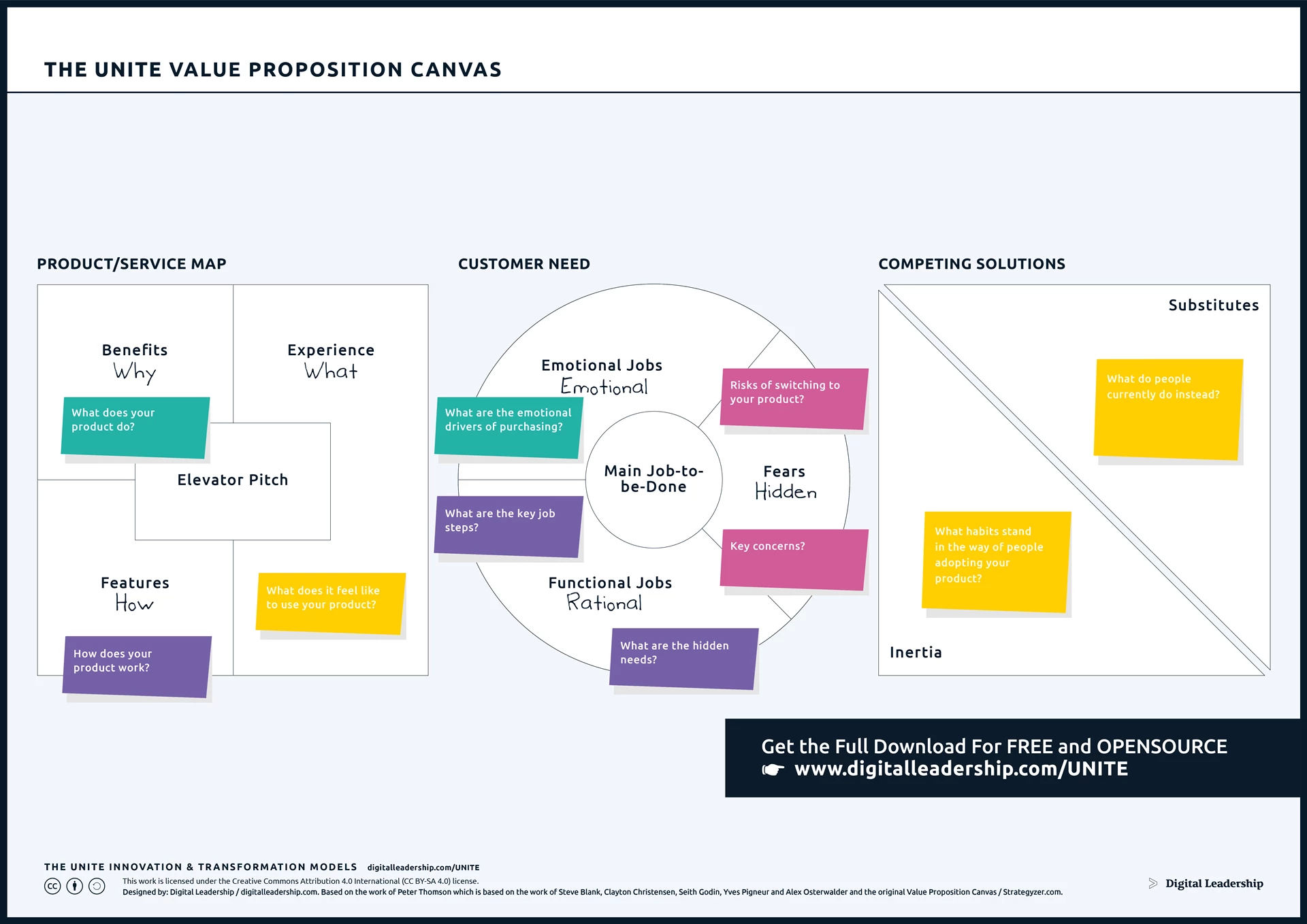
Designed by: Digital Leadership AG – Based on the work of Peter Thomson which is based on the work of Steve Blank, Clayton Christensen, Seith Godin, Yves Pigneur and Alex Osterwalder and the original Value Proposition Canvas
Integrating the Value Proposition Canvas into JTBD enhances strategic decision-making, fosters innovation, and ultimately contributes to the overall success of businesses.
Understanding the Jobs to be Done framework is pivotal in contemporary business strategy. JTBD goes beyond traditional product-centric perspectives, positing that customers essentially “hire” products to fulfil specific innovation jobs, be it solving a problem or satisfying a desire. In this section, we delve into the importance of JTBD in shaping business strategies.
The Business Model Canvas holds immense importance in the context of Jobs to Be Done (JTBD) as it serves as a valuable framework for visualizing and structuring business strategies. When integrated with JTBD, the canvas becomes a dynamic tool to analyze and align business activities with the identified jobs that customers aim to accomplish. It provides a holistic view of key components like customer segments, value propositions, distribution channels, and revenue streams, enhancing the overall understanding of how the business can effectively meet customer needs and enhance value creation.
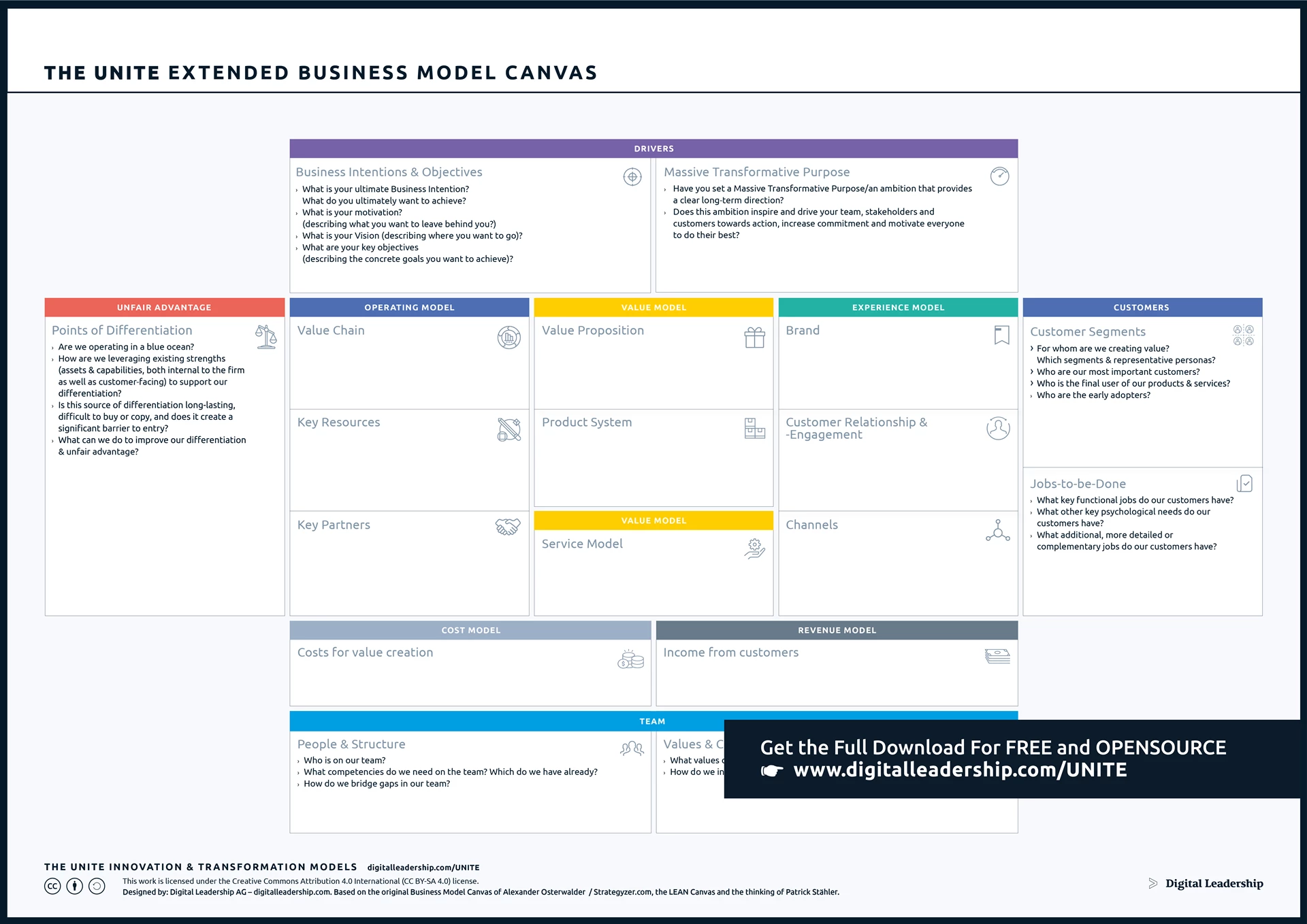
Designed by: Digital Leadership AG – Based on the Original Business Model Canvas of Alexander Osterwald, the Lean Canvas & the Thinking of Patrick Stahler
7 Jobs to Be Done Examples
1) Transportation Innovation:
- Customer job to be done: “I want a ride-hailing service that provides reliable transportation at the touch of a button”
- JTBD Perspective: Customers “hire” transportation like Uber to get from one place to another efficiently. This led to the rise of ridesharing services, providing a solution beyond car ownership for the job of reaching a destination.
Real-Life Example – Uber’s Impact:
Uber’s triumph is a testament to the Jobs to be Done (JTBD) theory’s impact on innovation, reshaping conventional approaches to transportation. By understanding that customers hire transportation for convenient point-to-point travel without car ownership, Uber revolutionized the industry. Meeting the need for flexibility and cost-efficiency, Uber introduced diverse service options like UberX and UberPOOL. The focus on a seamless digital experience, reflected in the app interface and cashless transactions, enhances the overall customer journey. Uber’s commitment to constant innovation, with offerings like Uber Eats and Uber Rewards, exemplifies the adaptability required to meet evolving JTBD and ensures its continued success.
2) Smartphone Evolution:
Traditional Assumption:
- Customer job to be done: “I want a mobile device that lets me listen to my music while I’m running”
- JTBD Perspective: Customers “hire” a device for staying connected Such as Apple’s Iphone, accessing information, and entertainment. This perspective fueled the evolution of smartphones into multifunctional devices, catering to various jobs beyond mere communication.
Real-Life Example – Apple’s iPhone Revolution:
The iPhone, crafted with deep insights from Jobs to Be Done (JTBD), serves as a unified communication hub by addressing diverse customer needs. From consolidating communication channels to providing instant information access and portable entertainment, it continuously innovates to meet evolving customer demands. The iPhone stands as a testament to Apple’s commitment to understanding and fulfilling JTBD effectively.
3) Online Shopping Paradigm:
- Traditional Assumption: Customers shop online for convenience.
- Customer job to be done: “I want to easily shop for the book I want and get it quickly”
- JTBD Perspective: Customers “hire” online shopping as “Amazon” to save time, discover a variety of options, and enjoy the convenience of doorstep delivery. E-commerce platforms evolved by enhancing user interfaces and optimizing logistics to better serve these jobs.
Real-Life Example – Amazon’s Customer-Centric Transformation:
Amazon’s transformative approach to online shopping reflects a profound understanding of the Jobs to Be Done (JTBD) theory. Recognizing that customers hire online shopping for specific jobs, Amazon has streamlined the process with features like one-click purchasing and personalized recommendations to save time. The vast product catalogue and third-party sellers cater to the need for a diverse range of products, while services like Prime delivery prioritize convenience. Amazon’s commitment to constant innovation, seen in initiatives like Prime Day and smart home integration, reflects an ongoing response to evolving customer expectations. This customer-centric transformation showcases the effectiveness of aligning with JTBD insights in creating a dynamic and enhanced online shopping experience.
4) Fitness Tracking Revolution:
- Traditional Assumption: Customers purchase fitness trackers for health monitoring.
- Customer job to be done: “I want a fitness tracker that helps me monitor my workouts and track my progress”
- JTBD Perspective: Customers “hire” a tool for maintaining a healthy lifestyle, beyond mere health tracking. Fitness trackers evolved to meet the broader job of supporting overall well-being.
Real-Life Example – Fitbit:
Fitbit recognized that customers were not just seeking health data; they aimed to enhance their overall well-being. Fitbit’s response was to offer features beyond basic tracking, including sleep monitoring, personalized fitness guidance, and stress management. By aligning with the comprehensive job of maintaining a healthy lifestyle, Fitbit became a leader in the fitness tracking industry.
5) Communication Platform Revolution:
- Traditional Assumption: Users adopt communication platforms for connectivity.
- Customer job to be done: “I want a communication platform that allows me to connect with colleagues and collaborate on projects remotely”
- JTBD Perspective: Users “hire” communication platforms for seamless collaboration, efficient information exchange, and real-time connection. This perspective has propelled the evolution of communication platforms into multifaceted tools, addressing the diverse jobs of users in various professional and personal contexts.
Real-life Example: Slack Application
Customers are not merely seeking a tool for sending messages; they are hiring solutions that cater to the broader job of seamless remote collaboration. A poignant example is the success of Slack, which recognized the fundamental shift in workplace dynamics. Teams, once reliant on traditional email communication, were now aspiring for a platform that could serve as a centralized hub for project collaboration, information sharing, and cohesive teamwork, especially in remote settings. Slack’s innovative approach addressed this job to be done by offering features like threaded conversations, file sharing, and integrations, transforming it into a comprehensive communication platform.
6) Streaming Services Transformation:
- Traditional Assumption: Customers subscribe to streaming services for access to content.
- Customer JTBD: “I want a streaming service that provides diverse content to cater to my relaxation, entertainment, and informational needs.”
- JTBD Perspective: Customers “hire” entertainment to relax, unwind, and stay informed. Streaming services recognized this job and diversified their content to offer a comprehensive solution for varied entertainment needs.
Real-life Example: Netflix
The Jobs to Be Done (JTBD) perspective brought a transformative shift, understanding that customers “hire” entertainment to relax, unwind, and stay informed. A notable example is the evolution of Netflix. Instead of focusing solely on content availability, Netflix recognized the broader job customers were trying to fulfil—seeking diverse forms of entertainment.
By introducing a vast array of movies, TV shows, documentaries, and original content, Netflix positioned itself as a one-stop solution for varied entertainment needs. This strategic move was not just about providing access to content; it was about meeting the deeper requirements of customers seeking relaxation and enjoyment, demonstrating the potency of JTBD in reshaping the streaming services landscape.
7) Health and Wellness Apps Evolution:
- Traditional Assumption: Users download health apps for tracking fitness metrics.
- Customer Job to be Done: “I want to easily access resources that help me manage and improve my overall well-being, incorporating fitness, nutrition, and mental health support into a seamless and personalized experience.
- JTBD Perspective: Users “hire” health and wellness apps for personalized well-being management. These apps have transformed into comprehensive platforms, offering features like personalized workout plans, nutrition guidance, and mental health support, aligning with users’ broader goals of holistic health.
Real-Life Example: My Fitness Pal
MyFitnessPal is a prime illustration of this evolution. Originally designed for tracking calories and exercise, it expanded its features to include a broader range of health metrics, personalized recommendations, and a supportive community, addressing users’ diverse well-being goals.
Jobs to Be Done Framework
The Jobs to Be Done (JTBD) Framework is an outcome driven innovation process crafted to identify and tackle customer pain points. Instead of generating solutions in isolation, this framework emphasizes the importance of understanding crucial yet unmet user needs. Through a series of well-defined steps, organizations can assess customer needs and strategically align their efforts to fulfil them. The JTBD Framework translates the Jobs to be Done Theory into practical implementation, offering a clear pathway rooted in the theory’s underlying philosophy.
Jobs to Be Done (JTBD) Framework is a strategic approach and methodology that originated in the fields of innovation, product development, and business strategy. Developed by Harvard Business School professor Clayton Christensen and further refined by practitioners like Tony Ulwick, the JTBD Framework provides a unique perspective on understanding customer behavior and driving innovation.
Key Components of the JTBD Framework:
- Jobs:
- Definition: In the context of JTBD, a “job” refers to a task, problem, or goal that a person wants to accomplish.
- Significance: Understanding the fundamental jobs that customers are trying to get done is central to the framework.
- Job Executor:
- Definition: The person or entity trying to get a job done, which can be an individual, a group, or a company.
- Significance: Identifying the job executor is crucial for tailoring products or services to their specific needs.
- Job Map:
- Definition: A visual representation of the various steps and stages involved in completing a job.
- Significance: Helps in breaking down the job into components, understanding the customer journey, and identifying pain points.
- Job Statement:
- Definition: A concise articulation of the job that a person is trying to get done.
- Significance: Provides a clear and focused understanding of the customer’s motivation and expected outcome.
- Switching Costs:
- Definition: Involves the costs, both real and perceived, associated with customers switching from one product or service to another.
- Significance: Recognizes that customers “hire” products to fulfill specific jobs and may “fire” them if the job is no longer served.
Application of the JTBD Framework:
- Research and Discovery:
- Understanding customer needs and motivations by conducting in-depth research, interviews, and analysis.
- Job Mapping:
- Breaking down the job into its various steps and creating a visual representation of the customer journey.
- Identifying Opportunities:
- Recognizing areas where innovation can address unmet customer needs or improve existing solutions.
- Product Development:
- Designing and developing products or services that align with the identified jobs and customer expectations.
- Marketing Strategy:
- Creating targeted marketing strategies that communicate how products fulfill specific customer jobs.
The Jobs to Be Done (JTBD) Framework is pivotal for business growth due to several key reasons:
- Customer-Centric Innovation: Shifts focus from products to customer needs, driving loyalty and attracting new customers.
- Market Alignment: Ensures offerings align with real customer demands, providing a competitive edge.
- Strategic Decision-Making: Guides informed decisions across product development and marketing.
- Reduced Risk of Failure: Targets customer needs, minimizing the risk of developing unsuccessful products.
- Enhanced Customer Satisfaction: Meets fundamental customer needs, fostering positive experiences and retention.
- Adaptability to Changing Markets: Equips businesses to adapt to evolving customer preferences for sustained growth.
- Efficient Resource Allocation: Focuses efforts and resources on high-priority customer jobs, optimizing efficiency and ROI.
How to Apply Templates to Jobs to be Done Framework Step by Step?
Step (1): Framing the job to be Done
Framing the Job to be Done involves crafting a concise and customer-centric Job Statement using the provided structure
You are going to frame a Job to be Done, in two steps:
1. The one sentence Job Statement helps you articulate the customer’s need in a given situation using their voice.
2. The eight steps of the Job Map help you discover the smaller tasks and activities customers are
1- The Customer’s Job Statement
The Customer’s Job Statement is a succinct expression of the customer’s need, articulated in their own words. This statement aims to capture the desired outcome or challenge they seek to overcome. It is written using a structured sentence format that includes the customer’s voice, direction of improvement, what is being improved, what or who is affected by the improvement, and a contextual clarifier. The statement should be clear, unambiguous, and solution-agnostic. Here’s an example: “As a parent, I want to increase the safety of my child when they start driving for the first time.”
The UNITE Jobs to Be Done Customer’s Job Statement Model emphasizes creating clear, concise statements that capture the essence of customer needs, forming the foundation for the Jobs to Be Done Framework. These statements, insightful revelations rather than mere descriptions, align organizational strategies with genuine customer needs. It facilitates a deep understanding of customer desires, enhancing the entire Jobs to Be Done process’s effectiveness.

Designed by: Digital Leadership AG – Source: Helge Tennø.
2. The Job Map
The Job Map is a comprehensive tool within the Jobs to be Done (JTBD) framework, designed to outline the various steps and tasks customers undertake to accomplish a specific job. Understanding and mapping out these steps is crucial for gaining insights into customer behavior and needs. Using the eight steps of the Job Mapping you are going to outline the smaller tasks and activities customers are doing to accomplish their job.
Incorporating “The UNITE Jobs to Be Done Universal Map” Model enhances this step. It provides a visual representation, ensuring a comprehensive understanding of the customer journey, and helping businesses align strategies with identified jobs effectively.
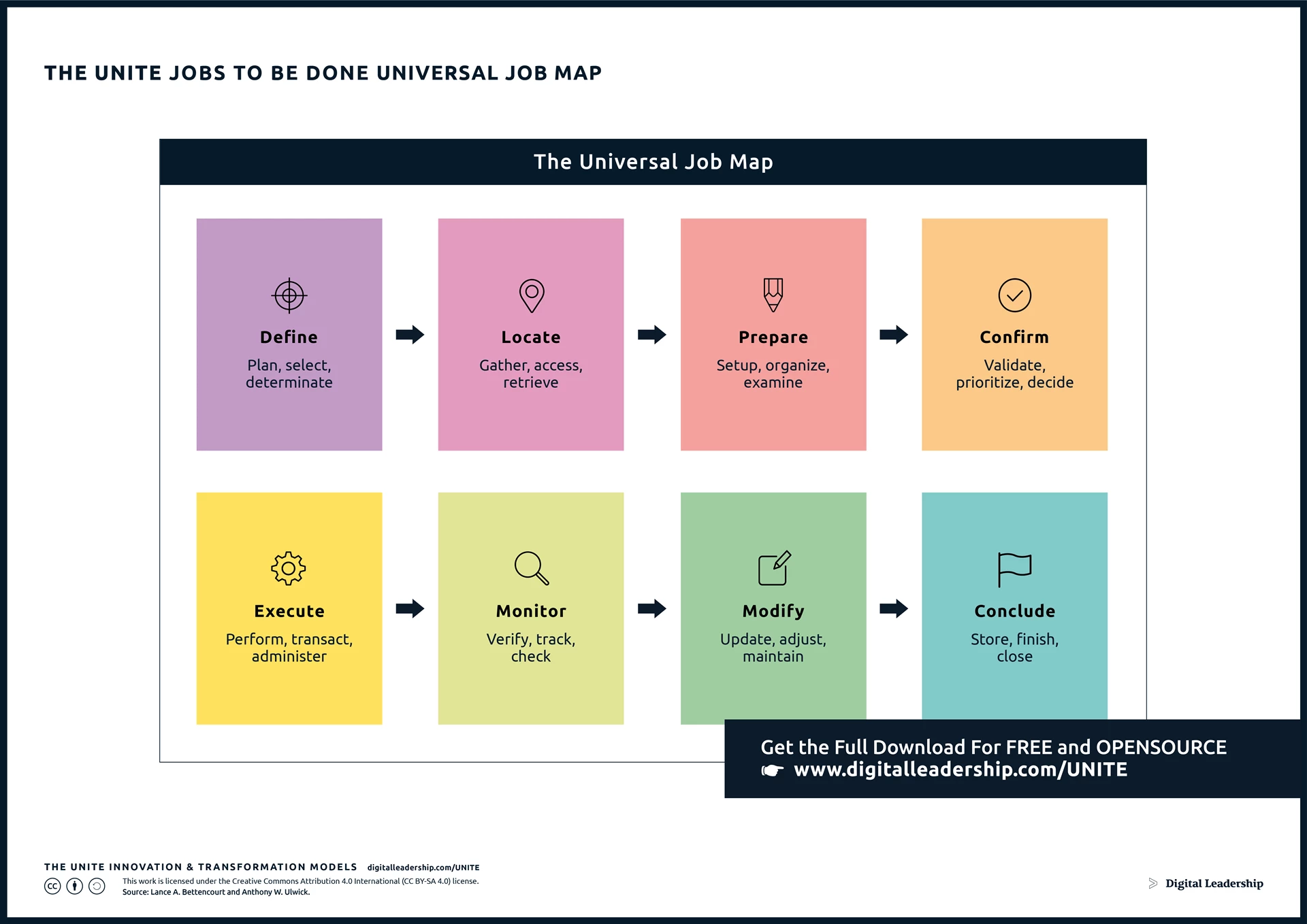
Designed by: Digital Leadership AG – Source: Lance A. Bettencourt and Anthony W. Ulwick.
The Job Map involves outlining the smaller tasks and activities that customers undertake to accomplish their job. This is a collaborative process where the team gathers to brainstorm and categorize tasks into eight steps. The Universal Job Map comprises the following steps:
- Define and plan: The customer consciously or subconsciously creates an initial plan for their approach.
- Locate the input needed: Identifying and locating information necessary for decision-making.
- Prepare: Organizing information, filtering, qualifying, and making decisions.
- Confirm and validate: Making decisions and validating them.
- Execute: Performing the action or procedure resulting from the decision.
- Monitor: Monitoring the effects and outcomes of the decision.
- Modify: Assessing the decision based on new information and continuously monitoring or improving.
- Conclude: Concluding the journey, taking stock, and learning from the experience.
Step (2): Discovering Customer Jobs through interviews
The Jobs to Be Done (JTBD) methodology emphasizes the importance of qualitative interviews in the process of discovering and understanding customer needs. The approach involves a series of steps to refine the Job Statement and create an effective Job Map through direct interaction with customers.
Following the qualitative interviews, Validating Customer Criteria with Data involves employing data-driven methods to identify and comprehend customer criteria. By utilizing this template, businesses can systematically analyze data, ensuring a comprehensive understanding of the criteria that influence customer decision-making processes. This step enhances the precision of subsequent actions within the Jobs to Be Done Framework.
The UNITE Jobs-to-be-Done template is recommended for defining Customer Criteria, providing a structured approach to gathering essential information for the product development process. The methodology encourages a holistic understanding of customer needs and preferences, ensuring that products align closely with the jobs customers are trying to get done.

Designed by: Digital Leadership AG – Source: Strategyn
Step (3) Validate with Data
After conducting qualitative interviews and identifying the most crucial Customer Criteria, the next step involves validating these insights and pinpointing significant growth opportunities. This phase entails a comprehensive quantitative survey that covers the final 50–150 Customer Criteria. For each criterion, your target audience will be asked two key questions:
- Importance Assessment: Participants rate the importance of each criterion on a scale from 1 to 5.
- Satisfaction Evaluation: Participants assess their current satisfaction with the available options for fulfilling the criterion, using a scale from 1 to 5.
To ensure statistical significance, survey a minimum of 60 people, with a preference for a larger sample size of 200-1,000 respondents. While this level of surveying might seem extensive, the insights gained will play a pivotal role in shaping the future of your business. It’s an investment worth making.
Step (4): Identify the Big Opportunities
In this phase, the insights gained from the quantitative interview are translated into actionable visualizations for the team’s immediate understanding. Utilizing tools such as the Job Journey Navigator, like the one offered by Vendbridge, every Customer Criterion is mapped out in alignment with the previously created Job Map. This visualization assists the team in easily identifying significant opportunities, facilitating prioritization for envisioning potential solutions.
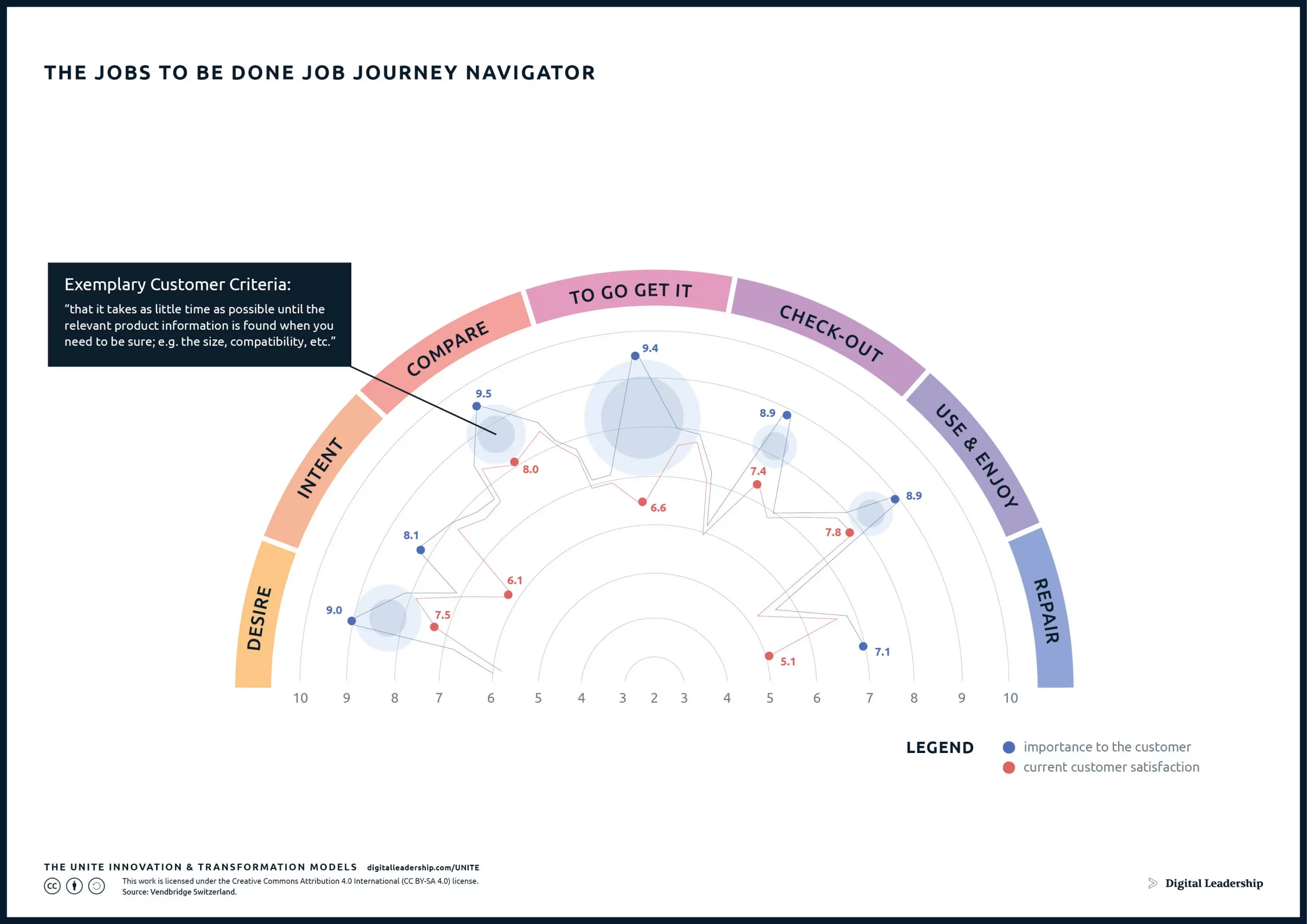
Designed by: Digital Leadership AG – Source: Vendbridge Switzerland.
To efficiently represent the survey data, the Top 2 Box method is recommended. This method involves consolidating the total percentage of responses belonging to the two highest scores for each criterion, streamlining the visual representation.
With the data visualized, the team analyzes the results, specifically focusing on areas with significant gaps. These gaps represent scenarios where the importance to the customer is high (blue line) while current customer satisfaction is low (red line). This detailed understanding of the customers’ most critical yet underserved needs enables the identification of the most promising opportunities for future innovations.
It’s essential to recognize that the biggest gap may not necessarily be the easiest or best fit for your company. The next step involves grouping identified gaps into logical categories, considering potential clusters of opportunities tailored to different customer segments. This strategic categorization sets the stage for the subsequent exploration of these opportunities.
Step (5): Spin towards solutions
Now that you’ve delved into understanding customer needs and prioritized opportunities with the Job Journey Navigator, shift focus to aligning those needs with your business. From the identified opportunities, narrow down the selection to a few that warrant significant investments. In this step:
- Identify Unmet Needs: Begin with the prioritized opportunities from the Job Journey Navigator.
- Articulate a Promise: Define a high-level promise that addresses the unmet customer need, forming the basis for your Value Proposition.
- Provide Proof: Validate your promise by explaining why it is the right solution for the customer’s job.
- Assess Business Capabilities: Evaluate if your organization can realistically build and deliver on the promise, leveraging core and differentiating capabilities.
Consider turning the UNITE Customer Promise Canvas into a team competition. Have individuals collaborate to create competing promises for the same unmet need, using the scoring mechanism on the canvas to determine the most effective solution. The canvas serves as a tool to explore how needs align with promises and helps filter opportunities, leaving you more confident and enthusiastic about the selected promises.
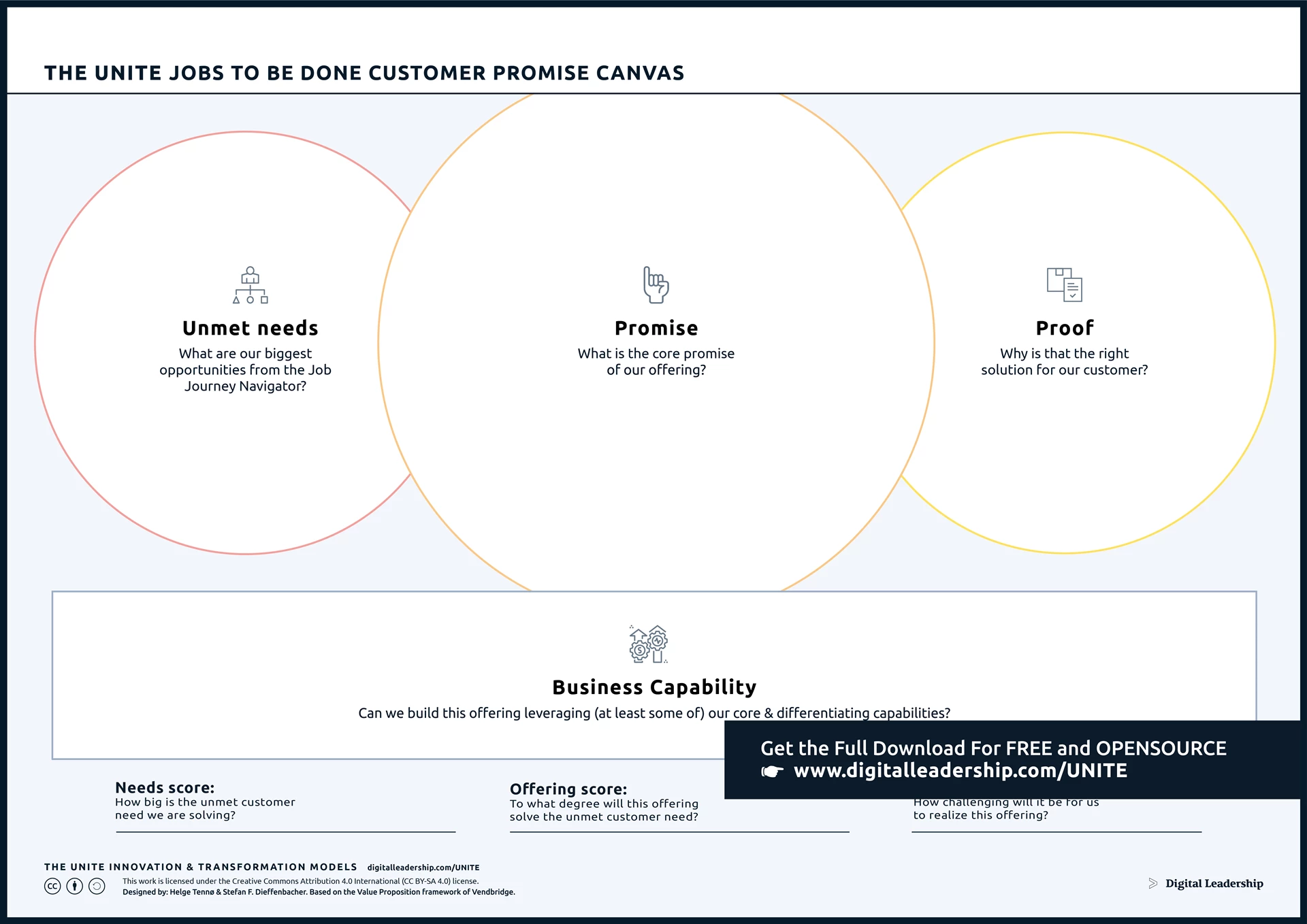
Designed by: Helge Tennø & Stefan F. Dieffenbacher. Based on the Value Proposition framework of Vendbridge
Jobs to be Done Statement Creation
Crafting an effective Jobs to Be Done (JTBD) statement is a pivotal step in understanding the fundamental objectives customers seek to achieve. This process involves identifying the core job with a focus on the key objectives and desired outcomes. It is crucial to ensure that the statement remains solution-agnostic, free from specific product or service references, and stripped of details regarding current methods or potential solutions. The stability of the statement over time is emphasized, with a goal to endure despite changes in technology or market trends.
Additionally, the statement should be measurable and controllable, allowing for objective assessment and being within the customer’s sphere of influence. Structuring the statement for reliable prioritization is essential, outlining clear criteria for ranking different desired outcomes. The statement should be intricately tied to the underlying job the customer aims to accomplish, establishing a direct link between the desired outcome and the broader context of the customer’s objective.
Utilizing models like the UNITE Jobs to Be Done Customer’s Job Statement Model can provide a structured approach, focusing on insightful revelations. Continuous review and refinement of the JTBD statement based on customer feedback and ongoing analysis ensure its accuracy in reflecting customer perspectives and aspirations.

Designed by: Digital Leadership AG – Source: Helge Tennø.
What is Jobs to be Done Theory History
Jobs Theory provides a comprehensive framework for categorizing, defining, capturing, and organizing the inputs necessary to make innovation a more predictable and strategic process. By understanding the fundamental jobs or tasks that customers are trying to accomplish, businesses can effectively shape their innovation strategies, ensuring they align closely with customer needs and preferences. This framework serves as a valuable guide, offering insights into the critical aspects of innovation that contribute to its success.
The Jobs to be Done (JTBD) theory has significantly impacted the landscape of innovation, providing a comprehensive framework that transforms how businesses approach the development of products and services. Originating in the early 1990s, the theory gained prominence through the efforts of Harvard Business School professor Clayton Christensen and his colleagues Scott D. Anthony and Gerald Berstell.
The key milestones include the influential book “The Innovator’s Dilemma” (1997), where Clayton Christensen expanded on the theory, emphasizing the misinterpretation of competition and innovation as a significant factor in company failures. The framework’s development incorporated the identification of functional, emotional, and social jobs that customers aim to fulfill. It became a guiding principle in understanding disruptive innovation and expanded beyond products to encompass services, experiences, and broader business strategies.
The JTBD theory has experienced a resurgence in popularity, with companies across industries adopting its principles to inform critical aspects of business decision-making, such as product development and marketing strategies. The theory’s ongoing evolution is marked by its global influence, transcending its origins in the United States, and becoming a universally recognized and applied concept. In digital transformation, the JTBD theory remains indispensable, guiding businesses to navigate the complex landscape of evolving customer expectations and technological advancements. It continues to serve as a valuable guide for crafting effective strategies that align closely with customer needs, contributing to the success of innovation and digital transformation initiatives.
Building Blocks of JTBD Theory
The Jobs to be Done (JTBD) theory serves as a foundational framework, transcending demographic assumptions to understand why customers choose specific products. Its building blocks include understanding “Customer Jobs” to reveal insights into needs and motivations. These building blocks guide organizations in understanding customer needs and developing purposeful solutions effectively.
- “Job Mapping” visually represents the customer’s journey, aiding refinement of offerings.
- Crafting a clear “Job Statement” and using the “Universal Map” through detailed interviews unveils desired outcomes.
- “Customer Criteria” involves data collection using templates to define benchmarks.
- “Opportunities Identification” analyzes data to pinpoint areas for innovation, addressing unmet needs.
- “Constraints and Obstacles” critically assess limitations, ensuring practical solutions.
- “Solutions and Innovation” focus on developing offerings, using tools like the UNITE Jobs to Be Done Customer Promise Canvas.
- “Testing and Iteration” involve real-world testing and continuous refinement.
- “Strategic Alignment” ensures solutions align with broader goals, fostering a purpose-driven approach.
In addition to these building blocks, the JTBD theory delves into fundamental elements that shape consumer behavior. The theory emphasizes a comprehensive understanding, unraveling the intricacies of its impactful framework. From “Customer Jobs” providing insights into needs to “Job Mapping” identifying pain points, and “Strategic Alignment” fostering a purpose-driven approach, the JTBD framework offers a systematic and insightful guide for organizations navigating innovation and customer-centric development.
The Jobs to be Done (JTBD) theory serves as a foundational framework for understanding why customers make specific product choices. It delves into the fundamental elements that shape consumer behavior, moving beyond demographic assumptions. To comprehend the essence of JTBD, one must explore its building blocks, unraveling the intricacies of this impactful theory.
Appling JTBD Framework in Innovation and Digital Transformation Strategy Importance
The Jobs to be Done (JTBD) Framework is of paramount importance in innovation and digital transformation, offering a strategic and customer-centric approach. In the innovation domain, this framework prioritizes customer needs, offering insights into unmet needs and guiding proactive problem-solving. It serves as a structured guide for strategic product development, enabling organizations to differentiate themselves, make informed decisions, and stay adaptable to changing markets. Integrating the JTBD principles into a comprehensive digital transformation strategy, the Unite Innovation approach model facilitates a step-by-step process for innovation aligned with customer jobs, ensuring organizations navigate the complexities of digital evolution while staying rooted in understanding and addressing customer needs effectively.
In the context of digital transformation, the JTBD Framework plays a crucial role in ensuring a customer-centric approach. By aligning digital strategies with specific customer needs, organizations can enhance user experiences and make informed technology investments. The framework supports the development of agile solutions, aligns digital efforts with broader business goals, and promotes data-driven decision-making. Continuous innovation is fostered by staying attuned to evolving customer jobs and market demands. Strategic technology integration is emphasized, fulfilling specific customer jobs for a meaningful transformation.
The Unite Innovation approach model serves as a structured guide, providing a step-by-step process for organizations to innovate in alignment with customer jobs. By integrating JTBD principles with our innovation approach model, businesses can navigate beyond surface-level understanding, ensuring a comprehensive and effective innovation strategy jobs.

Designed by: Digital Leadership AG
Jobs to be Done (JTBD) provides organizations with a profound understanding of customer needs and motivations for innovation and digital transformation, Digital Leadership integrates Jobs to be Done (JTBD) principles seamlessly into its Innovation Consulting and Digital Transformation Consulting services. By decoding fundamental customer jobs, our approach ensures strategic innovation aligned with market needs.
How To Use JTBD Yourself in Business
Leveraging Jobs To Be Done (JTBD) in your business can be a game-changer for innovation, customer satisfaction, and crafting a compelling value proposition.
- Begin by engaging in comprehensive customer interviews to unveil the underlying jobs they aim to accomplish. Identify unmet needs and pain points, then visualize the customer journey through job mapping.
- Craft clear JTBD statements to articulate desired outcomes.
- Employ quantitative surveys to quantify the importance of different jobs and customer satisfaction levels.
- Analyze competitors to identify areas for improvement and innovation.
- Pinpoint opportunities for enhancement through data analysis and address realistic constraints.
- Develop solutions aligned with identified jobs, utilizing tools like the UNITE Jobs to Be Done Customer Promise Canvas.
- Test and iterate in the real world, gathering feedback for continuous refinement.
- Ensure your business strategy strategically aligns with addressing the most critical customer jobs, contributing to broader organizational goals.
By following these steps, your business can transform its approach, understanding customer needs more profoundly, and crafting a compelling value proposition that resonates with your target audience.
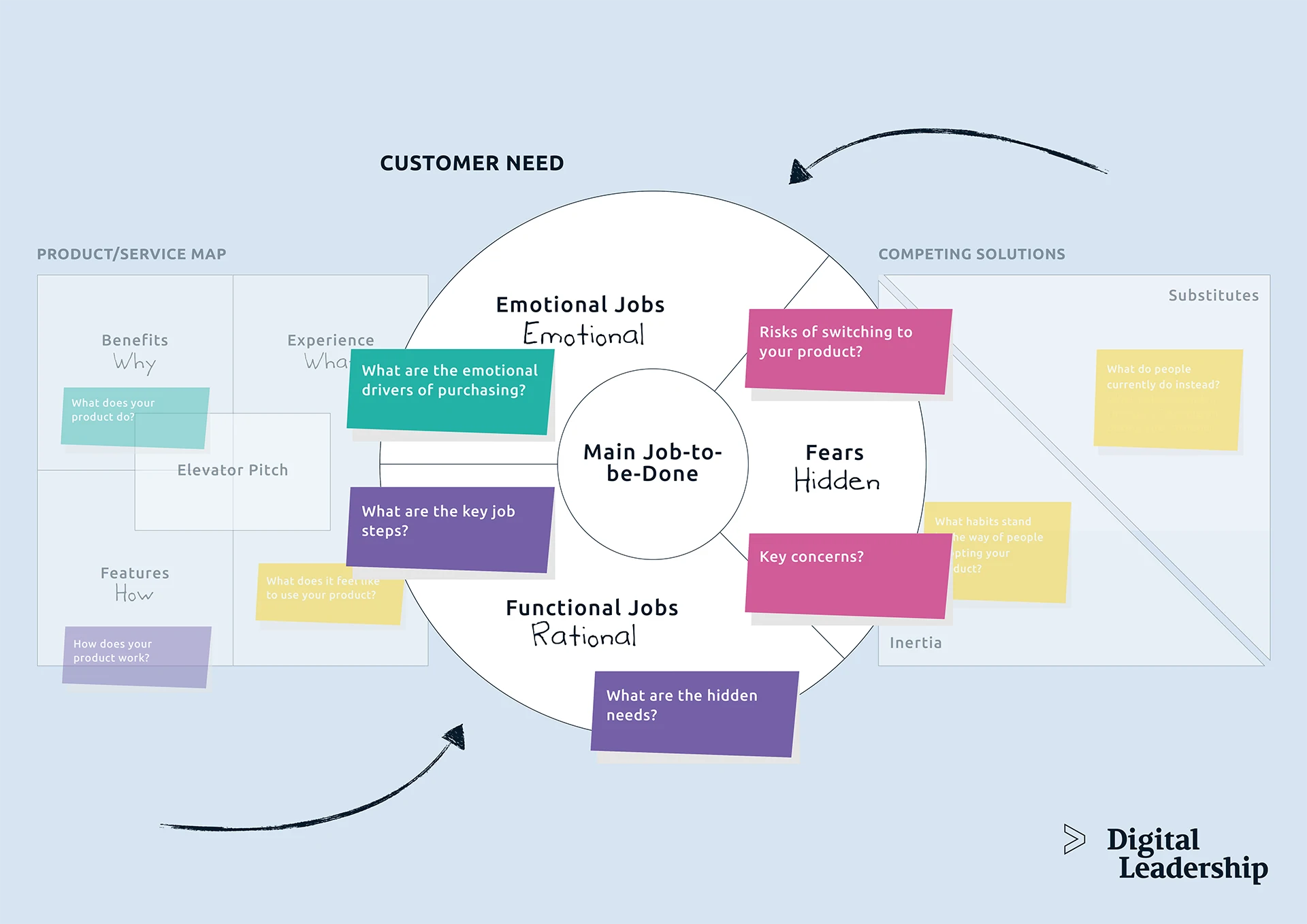
Conclusion
In mastering the Jobs to Be Done (JTBD) Framework, organizations embark on a strategic journey that aligns innovation with customer needs. Through the 10 steps, from identifying key players to iterative improvements, businesses cultivate a deep understanding of customer desires. This approach goes beyond product development, influencing strategic decisions, reducing risk, and fostering adaptability to changing markets.
As organizations delve into the realm of JTBD, they embark on a transformative journey that places the customer at the core of their strategies. The insights gained from discerning the fundamental tasks customers aim to accomplish drive meaningful, purpose-driven innovation. The adaptability, flexibility, and long-term relevance ensured by JTBD pave the way for businesses to not only meet but exceed customer expectations, fostering a lasting and mutually beneficial customer relationship. In the era of continuous improvement, the JTBD Framework stands as an indispensable ally, guiding organizations towards sustained growth and innovation.
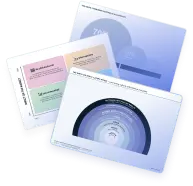

































 Book How to Create Innovation
Book How to Create Innovation